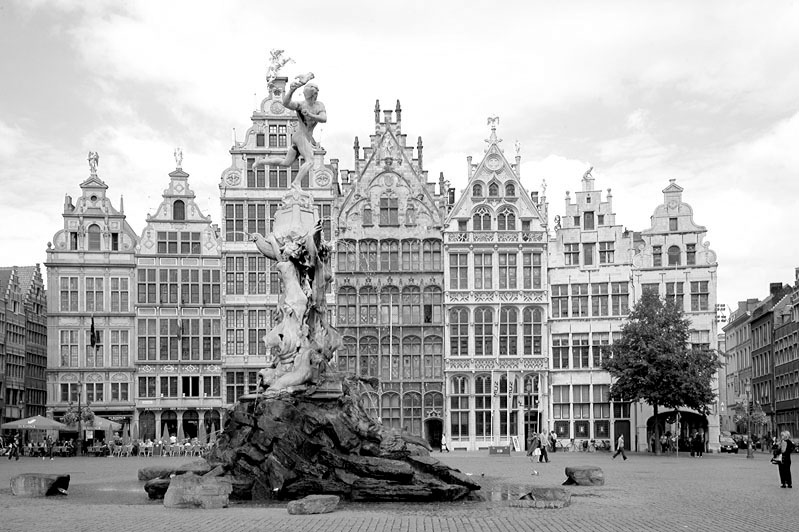
In the 17th century Antwerp was even called Handwerpen (throw a hand) for a few years.
Was a giant the reason for the origin of the name Antwerp?
On an island in the river Schelde, close to the mouth of the sea was a castle.
In that castle lived a giant called Druon Antigoon.
It was a horrible time for the captains who sailed up and down the Scheldt.
In the past it was enough to pay the Scheldt a small toll. But the giant Druon Antigoon demanded more and more from the captains. He was not satisfied with a tenth, no he demanded half of everything that went past his castle.
And woe to the skipper who did not comply with this. Woe to those who tried to slip past the castle by night and fool in order to avoid the toll of the giant Druon. They were difficult times for the skippers.
The giant was always at his post. Nothing escaped him. The refusing skipper had to hand over half of his load or his right hand went off.
The giant could not be relented. No toll, then the right hand. With a hew of his huge sword he cut his hand at the wrist and threw it into the Scheldt.
But there would be an end to the violent acts of the giant. A Roman soldier Salvus Brabo king of Tongeren and related to the Roman emperor Julius Caesar went out and defeated the giant.
After defeating him he cut off the giant’s right hand and threw it into the Scheldt.
Exactly like the giant had done with so many defenseless skipper. So the giant got his earned wages.
No one knows for sure how things have gone with Druon Antigoon. But he did not reside at the castle anymore and the skippers were no longer deprived of their half load and their right hand was spared. Brabo, of course, got his reward. Brabo was promoted to duke of Brabant. Julius Caesar knew how to appreciate his brave deed. But no one has ever seen anything from that giant since that time.
He only lived on in the memory. So much so that the name “Antwerp” was created by his “hands”. A myth or a true story?
The first versions of this story date back to the 13th century and from 1471 it takes shape as now known.
In the 17th century Antwerp was even called Handwerpen (throw a hand) for a few years.

Picture of Suikerrui in Antwerp at 1918 (location of the new diamond museum)
How did Antwerp become the Center of diamond business?
It hasn’t always been like that. Until the 14th century Bruges, a capital situated in West Flanders, was actually far more important for the diamond trade.
In that time 99% of diamonds were mined in India and shipped to Europe through Venice after having travelled overland.
Transportation along routes like the Silk Route changed when Vasco da Gama discovered the sea route to India in 1498.
In the 15th century, Antwerp, a city located in the North of Belgium, became the most important harbor of Belgium, quickly taking over the diamond business not only in trade but also in diamond polishing. Soon Antwerp became the commercial and cultural center of the world and was living the Golden Century.
Not only diamonds, gold and silver were traded, also trading in objects of art and textile flourished; Flemish painters such as Rubens depicting refined jewellery on richly dressed models.
At that time Antwerp was home to many refugee Jews from Iberia, fleeing from the Moorish rulership. These Jewish businessmen were specialized in banking and trading diamonds. They prospered in the cosmopolitan city of Antwerp.
The diamond trade shifted to Amsterdam and London in the 17th and 18th century whilst Antwerp had to make do with second choice stones. However, Antwerp diamond cutters soon gained a reputation of being able to cut beautiful diamonds from these second class stones.
In 1866 De Beers started diamond mining in South Africa; generating a large influx of uncut stones into Europe, mainly through Antwerp’s harbor.
The importance of Antwerp as the world diamond center has grown ever since, with a brief interruption during the 1930’s, due to anti-Semitism on the continent.
Diamond trading in Antwerp steadily regained importance after WWII as the government issued strict regulations on diamond import and export.
Nowadays traders can benefit from its unique financial and commercial infrastructure,
Today about 85% of the world’s mined diamonds passes through Antwerp. Its diamond district is synonym for global diamond industry and highly skilled craftsmen: Flemish, Jewish Orthodox and Indian diamond traders are proud to present their gems, rough or polished. Expertise and experience, combined in just one city; Antwerp has no equal!
